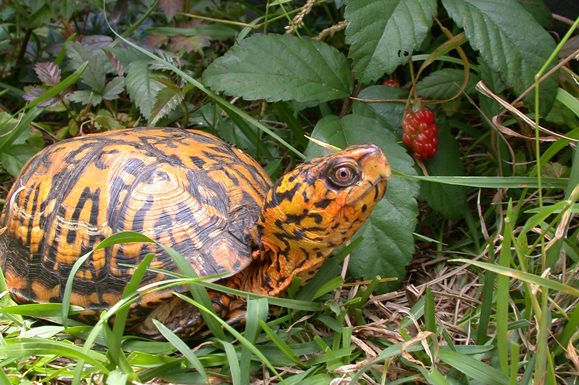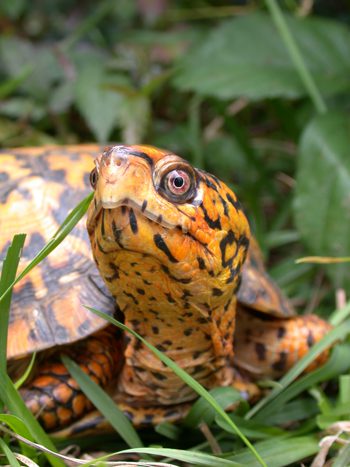Box turtles

My mom was putting out mulch about this time last year when she noticed a box turtle digging a hole in the dry, red clay under the eaves of the house. Eastern box turtles (Terrapene carolina carolina) appear in many types of habitat, making them a natural choice for our state reptile. Since they’re most plentiful in mature, moist forests with lots of undergrowth, they’re common in the Uwharries.
Mom kept working, and so did the turtle. She dug a hole shaped like a shallow soup bowl. It had a wider rim of loose dirt at the top, and in the center, there was a deeper cup of hard-packed clay about the size of a 50-cent piece. When the turtle moved a few feet away and started digging another hole, mom worried she’d interrupted her attempt to build a nest. Box turtles don’t begin to reproduce until they’re 7-10 years old, well into their typical lifespan of 25-30 years.
 Mom kept her distance this time, going up front to water and weed. She came around the corner of the house about an hour later, just in time to see the turtle laying her eggs. Once she finished, she covered the eggs with dirt and smoothed it over with her hind feet. After the turtle crawled away, mom flagged the nest. She watched it all summer, waiting for baby turtles to emerge. In August, she had to go out of town for a night, but she checked the nest as soon as she returned. To her dismay, the hole was uncovered. Pieces of eggshell lay around it, rolled and curled like shavings.
Mom kept her distance this time, going up front to water and weed. She came around the corner of the house about an hour later, just in time to see the turtle laying her eggs. Once she finished, she covered the eggs with dirt and smoothed it over with her hind feet. After the turtle crawled away, mom flagged the nest. She watched it all summer, waiting for baby turtles to emerge. In August, she had to go out of town for a night, but she checked the nest as soon as she returned. To her dismay, the hole was uncovered. Pieces of eggshell lay around it, rolled and curled like shavings.
Had the turtles hatched and dispersed? Had a predator found the nest? We’ll never know. The incubation period was about right, so we like to believe they hatched. If so, they’ll stay hidden in the undergrowth for several years as they develop their strong, protective shells. They’ll likely remain in the woods around the house throughout their life. Box turtles generally don’t range more than a couple hundred meters, but if they’re moved, they have a strong homing instinct to return to their birthplace. Sometimes they wander until they die. If you rescue a turtle crossing the road, leave it nearby in the direction it was heading.
Please resist the urge to take it home and keep it as a pet. Box turtles might seem sturdy, but it’s surprisingly hard to meet their needs in captivity. They require high humidity, areas for basking and bathing, and a diverse assortment of food. Why go to all that trouble when they’re so easy to observe in the wild? Even though their numbers are declining in much of their range – mostly due to habitat fragmentation and collection for the pet trade – they’re still relatively abundant. They’re also not as shy as other reptiles, and they don’t move quite as fast.
Dr. Michael Dorcas and his students at Davidson College have been studying their local box turtles for a dozen years. Their website (www.herpsofnc.org)is a great resource for facts about box turtles and other reptiles native to the state. Citizens are encouraged to participate in their study by helping collect information. Even though the box turtle study is limited to Davidson, you can contribute information about reptiles in the Uwharries through the Carolina Herp Atlas which you can access via their website. We’re hoping to document a successful box turtle nest under the eaves of the house this summer.
Photographs by J.D. Wilson of Virginia Tech.